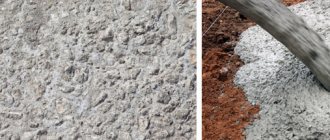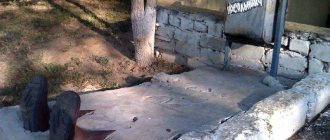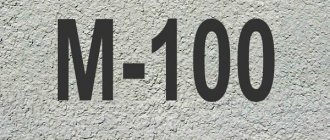Concrete M500 is a durable and reliable material that is not afraid of exposure to various negative factors and aggressive environments, can withstand maximum loads and last a long time. In private construction, concrete is rarely used due to the fact that its characteristics often exceed the normative ones and craftsmen simply do not see the point in high expenses.
The cost per cubic meter and the exact indicators of concrete depend on what materials are used in preparing the solution, whether there are additives to increase resistance to moisture and frost, and what their volume is in the mixture. Any heavy concrete 500 demonstrates excellent compressive strength characteristics, which is important in many areas of construction.
Specifications
Concrete grade 500 presupposes certain properties and indicators that the material must meet. Many parameters are significantly superior to the more popular cement brands in repair and construction work: M200 (concrete is not the strongest), M300 (concrete with average characteristics), M400.
Production of concrete mixture.
Main properties of M500 concrete:
- Strength - class B40, 51.73 MPa (the solution can withstand a load of 523.7 kilograms per cm2)
- Resistance to temperature changes – F200-F500
- Mobility (concrete on granite) – P2-P5
- Water resistance – W10-W16 (construction of structures to be used in water is allowed)
- Standard density of concrete M500 – 2298 kg/m3
- Weight of a cubic meter – 2298 kilograms
- Hardening time – 1-2 hours
Where is the ready-made BST M500 used?
Concrete mix class B40 is suitable for a limited number of jobs.
On its basis, bank vaults, dams, bridges, dams, bunkers, bomb shelters, and military facilities are created. For such structures, the BST brand has sufficient strength and the ability to withstand moisture. However, these properties make the solution unsuitable for ordinary residential construction. The mixture turns out to be excessively heavy, and its strength is unreasonably high for general purpose buildings. Liquid concrete grade M500 class B40 is suitable for the construction of highly loaded objects, as well as for casting individual elements, the reliability of which is subject to high requirements:
- crossbars;
- columns;
- beams;
- pool bowls;
- bridge elements.
The solution is also ordered for casting the foundations of multi-story buildings or skyscrapers, as well as for laying subway tunnels, organizing runways, and high-capacity highways.
Advantages and disadvantages
Unlike grades M200, M300 and others, M500 concrete demonstrates very high strength, durability, and resistance to different environments and influences. But the cost of the material is also high, so before using it in construction, it is necessary to carefully study all the properties and determine the feasibility of preparing the solution.
The main advantages of M500 concrete:
- High compressive strength, different types of mechanical impact - the material can only be damaged with a special diamond-coated tool
- High speed of hardening - this is not quick-drying cement, of course, but the mixture still sets quickly, even in conditions of high humidity levels
- Excellent resistance to moisture - due to the fact that the composition uses fine sand, which does not give water a chance to enter the pores of the monolith: thanks to this, the structures can be used even under water
- The composition of M500 concrete guarantees its immunity to strong winds, ultraviolet radiation, precipitation, etc.
- Long service life - structures and objects made from the material are not subject to independent deformation at all
Among the disadvantages, it is worth noting, first of all, that concrete grade M500 is very expensive and its increased characteristics are not relevant in everyday life, as they remain unclaimed. And preparing the solution will require considerable expense and effort. In Moscow and the region, and other regions, you can buy a dry mixture (it just doesn’t contain crushed stone), but you will need special equipment for mixing.
Price and transportation methods
Today, you can find both dry mixtures of M500 cement on sale, and you can also order ready-mixed concrete , which is delivered directly to the customer’s site using special car transporters.
Dry mixtures created for direct preparation on a construction site are primarily intended for small volumes of work, concreting for heavy-duty heavy structures or the production of small-sized reinforced concrete products. The cost of a 50 kilogram bag with material of this strength will be about 500-800 rubles. For large volumes of concreting work, M500 is ordered directly from the manufacturer’s plant with the material delivered on special car carriers. A giant concrete mixer mounted on a truck is constantly in motion, allowing the mixture to be kept in working condition for two to three hours. If long-term transportation is necessary, additional plasticizers and additives can be added to cement, which prevents rapid hardening, but increases the cost of this material. On average, the price of a cubic meter of ready-mixed concrete with strength M500 with delivery today is 3-5 thousand rubles.
Where is this brand of concrete used?
As indicated, concrete M 500 is practically not used in individual construction, since there is no need to provide such high parameters with a material that significantly increases construction costs.
Scope of application of M500 concrete:
- Construction of foundations for multi-storey buildings (skyscrapers) with a large mass in a minimal area
- Installation of bridge supports, various hydraulic structures and complex structures
- Design and installation of underground structures that are exposed to groundwater, soil loads - walls and subway supports, for example
- Defensive structures - due to the fact that M500 concrete has the best characteristics of thermal conductivity, strength, density, structures made from it are protected from temperature, fragments, powerful blast waves, even from radioactive radiation, etc.
- Hydraulic structures - piers, piers, breakwaters, hydroelectric power stations
- Construction of highways, bridge supports
- Installation of special (special) purpose objects - bunkers and others, for the construction of which even grade 500 concrete with lead shavings is used
Scope of use
When choosing a specific brand of concrete, it is extremely important to correctly determine the necessary characteristics of the material, which will directly determine the costs of construction work and the operational characteristics of the constructed buildings and structures.
Concrete marked M500 has excellent strength, but its high cost somewhat limits the use of this material. This mixture is used exclusively in cases where subsequently an increased load is placed on the erected structures. Concrete M500 is used in the following cases:
- Making foundations for complex and massive objects.
- Arrangement of supports for overpasses and bridges.
- Construction of hydraulic structures.
- Construction of special purpose objects.
- In high-rise monolithic construction.
It was the development of monolithic high-rise construction that affected the demand for this type of material. The massive foundation of the house is poured from such heavy-duty concrete, and the subsequent construction of load-bearing walls of high-rise structures, which bear a huge load during operation, is made from such a reliable and durable mixture.
In this case, it is simply impossible to use brick, foam concrete, or other types of concrete reinforced with reinforcement. Therefore, the appearance of the M500 made it possible to begin the construction of high-rise structures that fully meet all requirements for the safety and durability of structures.
Concrete composition
To determine the optimal proportions of M500 concrete, you first need to consider its composition. The solution contains certain ingredients, the quality and correct choice of which determines the quality of the mixture. The parameters of the finished solution are regulated by GOST 7473-2010.
What's in the mix:
- High-quality granite crushed stone of a fraction of 3-5 centimeters
– the stones must be the same so that the material takes the load evenly
- Fine sand
– thoroughly cleaned and washed, due to it the number of void areas is reduced and the density increases
- Cement grade M500
– you definitely can’t skimp on this ingredient, since it is what is responsible for the strength that grade 500 concrete will provide (the proportions must also be observed as accurately as possible)
- The water is clean
– after special filtration to eliminate the risk of organic impurities and salts entering the solution, which may interfere with standard setting
Areas of use of concrete m500
The scope of application of grade 500 concrete is explained by its performance characteristics.
In accordance with certificates, GOSTs and other regulatory documents, the material is used in the construction of structures:
- foundations for multi-storey buildings;
- bridge supports and other hydraulic structures;
- underground structures of metro stations that can withstand static loads;
- defense facilities capable of protecting against blast waves.
Since the process of preparing M500 B40 concrete is a rather expensive process in terms of financing, experts do not recommend using it for private construction.
How to prepare 500 grade concrete yourself
To prepare a high-quality solution, you need to know the ratios exactly. The proportions of M500 concrete may depend on the type and quality of the material and change accordingly. But it is still better to adhere to the standards so that instead of the required mixture you do not end up with a mixture of the M350 brand (concrete with average performance) or M450. Indeed, when constructing structures that will withstand enormous loads and difficult operating conditions, even a small deviation from standard indicators can be disastrous.
Proportions of concrete M500 (1:1.1:2.2:0.5):
- Cement – 10 kilograms
- River sand – 11 kilograms
- Crushed stone – 22 kilograms
- Water – 5 liters
This ratio is considered the most optimal for preparing M500 concrete. It is almost impossible to make such concrete at home - so, if M400 (concrete also with fairly high characteristics) can still be prepared at home, then M500 is better to order at the factory. When ordering a dry mixture, you also need to carefully select a supplier, making sure that he has the equipment necessary for the production of the material and all quality certificates.
Otherwise, you can buy a mixture that, according to regulatory parameters, will correspond to much lower grades and, under certain conditions, will lead to deformation of the structure, demonstrate strength class B22-25 instead of B40, and provoke other problems, which is simply unacceptable.
Concrete M500 is a strong and durable material that is quite expensive. Therefore, it is usually used where there is a need for increased parameters and improved properties, which fully justifies the high price.
Scope of application of concrete mix M500
Concrete M500 is the optimal solution for the construction of objects where maximum reliability and resistance to moisture are required from the starting materials. B40 concrete is suitable for construction:
- bridges and leading supporting structures;
- swimming pools and water parks;
- dams, dams;
- underground and near-water structures, bunkers of various types;
- nuclear power plants, airfields.
The material is very popular in the construction of docks, piers, and embankments. The indicator of resistance to mechanical loads and protection from moisture ensures the practicality and durability of the structures being built at optimal costs.
✅ The principle of determining the optimal ratio
Determining the proportional ratio of the components largely depends on the intended purpose and type of base. When diluting the solution with sand to create a screed for the floor surface and interior decoration of the room, the ratio is 1:3. Water is added to the mixture at the rate of “half a portion of the volume of cement.”
When planning to use it for brickwork, it is quite possible to prepare a solution in a ratio of 1:4. Some craftsmen add lime as a binding element to this composition, maintaining a ratio of 0.5-0.7 parts to one part sand. The resulting composition of soft, stretchy consistency is convenient to apply to a vertical surface in a thin layer.
In both cases, the amount of water volume is taken from the calculation “a portion of liquid is equal to the volume of cement.” The finished mixture should be homogeneous and elastic.
To make concrete, which is designed to withstand increased loads, the cement mixture is mixed with sand and crushed stone. The inclusion of crushed stone in the composition will increase the strength of the material and the bearing capacity of the base of the building. To do this, take 2 parts sand and 4 parts crushed stone for one part of the mixture. As when creating a floor screed, water is added to the mixture at the rate of “half a portion of the volume of cement.”
How to make a mortar of cement with sand: composition and proportions
Cement is not suitable for construction without prior preparation. To build any building, make a screed or fill anything with cement, you need to prepare a solution. To dilute the mixture, you must have at least 3 important components: water, sand, cement, and there are also other additives. Additionally, it is important to ensure that you have a concrete mixer or at least containers, shovels, trowels and buckets. After preliminary preparation, you can start diluting the mixture. In what proportions should cement and sand be diluted? Let's figure it out.
Delivery of BST B40 from 1 cubic meter. m in Moscow and the Moscow region
The finished solution is transported by mixers with a moving centrifuge, which prevents the concrete from hardening before arriving at the construction site. A concrete pump is used to supply the mixture, which simplifies working with dense material. ABN can be rented from RBU, and you can also choose a machine with a suitable boom length (up to 61 m).
The capacity of concrete mixer trucks ranges from 7 to 12 cubic meters. m. However, orders are also accepted for small deliveries from 1 cubic meter. m. BST M500 is produced at factories with a convenient geographical location, which ensures fast shipment to any point in the Moscow region.











